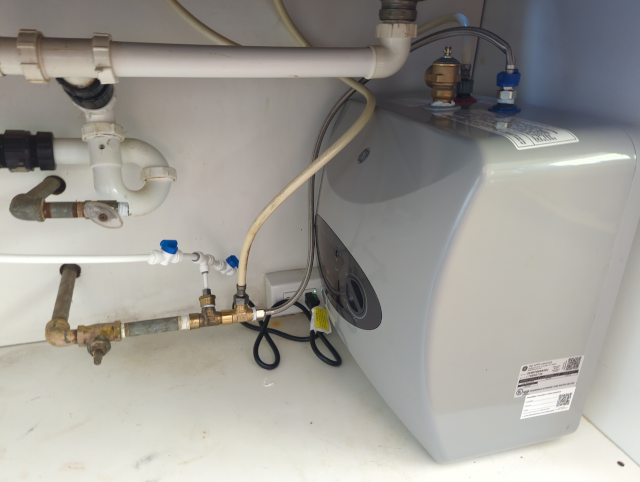
Because it is plumbing, I have continued to forget that I needed to connect the electric hot water heater (that I bought back in April) to the kitchen sink. It’s a bit of an experiment and a trade off.
Until now, the kitchen sink was served by a propane-fueled demand water heater located in the outdoor shower outbuilding. That worked passably well, but had a few problems:
-
There is about 15 feet of uninsulated pipe, exposed to the outdoors, from the demand heater to the kitchen. That meant the hot water at the kitchen sink often wasn’t, well, hot until you let it run for a while. That, in turn, meant that a lot of the propane one burned ended up just heating the ground outside, and a lot of water got wasted.
-
The demand heater needs considerable demand to be triggered, so we have to turn the sink wide open to get it going.
-
If someone’s using the kitchen hot water when someone else is showering, it adversely affects the ability to control the shower water temperature.
-
Burning propane is against twoprops’ “no burning for energy” policy.
-
The water temperature is deliberately set rather low to avoid the unpredictability of the mix at the shower from scalding us.
The point-of-use electric water heater aims to solve these problems, providing instant hot water at any flow rate. The downside is that it’s only a six-gallon tank, so if someone lets the hot water run continuously (don’t do that!) they’ll run out of hot water in about five minutes and it will take half an hour or so for the water to get up to temp.
My hope is that between having hotter water, having it available instantly, and not being flow-sensitive we’ll be able to be quite judicious in our hot water use, and that the six gallons will prove ample capacity even for washing dishes after a big party. If not, we’ll just have to take one or two 30-minute breaks during the wash up.
—2p